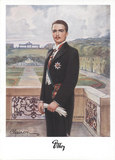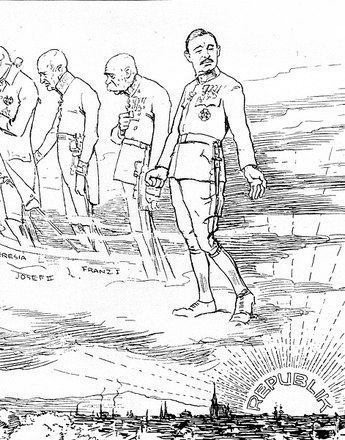
Otto Habsburg-Lothringen together with the members of the Heimatschutz, Botho Coreth, Arthur Karg von Bebenburg and Peter Revertera-Salandra on the occasion of the latters’ visit for the purpose of legitimist matters in Steenockerzeel, 1935
Copyright: ÖNB Bildarchiv
Partner: Austrian National Library
The 1930s saw the issue of the Habsburgs’ return brought back into the political arena in an active role. A chapter in Otto’s biography that has remained controversial to this day is his prominent association with Austrofascism. His committed efforts for the Austrian resistance in exile to the National Socialist regime are regarded in a far more positive light.
Following the dissolution of parliament in May 1934 a totalitarian regime modelled on Fascist Italy established itself in Austria. The Austrian corporative state became the bogeyman of the left as well as of the National Socialist faction, both of which had been driven underground.
Otto stylized himself as the leading figure of an independent, Catholic Austria that saw itself as the antithesis of National Socialist ideology. The latter was gaining in popularity and its increasing numbers of supporters were demanding Anschluss or annexation by Hitler’s Germany.
Otto let it be known that he was willing to return to Austria from exile and to take over the government as a demonstrative sign of Austria’s independence. Kurt Schuschnigg, who held the office of federal chancellor in this authoritarian state, was not opposed to the monarchist principle. However, he hesitated to accept Otto’s offer, as the return of the Habsburgs could be interpreted as a hostile act by the states of the Small Entente and would also provide Hitler with an excuse to invade.
Otto was in constant contact with Schuschnigg during this time, and tried in vain to effect a reconciliation with the Socialists, whom he saw as the most reliable allies in the fight against National Socialism. He warned against rapprochement with Nazi Germany and regarded the corporative state as the lesser evil given the threat from the National Socialists. Otto was trying out the role of smallest common denominator for the hostile Socialist and Conservative factions.
The Schuschnigg government reacted to Otto’s efforts with concessions in respect of the legal position of the former ruling dynasty. On 10 July 1935 the Habsburg Laws were revoked. Restitution of the family’s confiscated property began, and Otto was given permission to enter the country.
After Schuschnigg had been forced by Hitler to sign a treaty with Germany in Berchtesgaden on 12 February 1938 which amounted to the abolition of Austria’s independence as a country, Otto advised him to resign and put himself forward as federal chancellor in an open letter.
As a last resort, Schuschnigg announced a plebiscite to decide on Austria’s future as an independent state. Before it could be held, the German army invaded in the night of the 11-12 March 1938. Tellingly, the invasion was code-named Unternehmen Otto.
Otto made an official protest and travelled to Paris, where he began writing articles campaigning for an independent Austria. Many of his supporters in Austria were arrested by the Nazis and sent to concentration camps. Otto gathered political allies around him who had been forced to flee from Austria, becoming a figurehead of Austrian resistance in exile in the West. He was promptly declared a traitor by Hitler and put on a ‘wanted’ list.
In 1940 Otto travelled to the United States and in meetings, talks and lectures attempted to portray Austria as a victim of Hitler’s aggression. The climax of his journey was a speech to Congress and two meetings with President Roosevelt. Otto campaigned for an independent Austria, advocating the idea of a Danube Federation uniting the peoples of Central Europe as the only possibility of halting the advance of Communism.
After his return to Europe in May 1940 he was forced to flee in the face of the German invasion of Belgium and France. He obtained asylum in the United States, moving to Washington in 1941 in order to maintain his connections with government circles. Supported by his brothers and sisters and other relatives he became a lobbyist for the post-war restoration of Austria. His attempts to form an Austrian government in exile foundered on the objections of the Social Democrats, who refused to collaborate under the leadership of the former emperor’s son.
Immediately after the war had ended Otto attempted to gain a political foothold in Austria. In Innsbruck, where he was given an enthusiastic welcome, he started to agitate against the government of Karl Renner in Vienna, which he regarded as a puppet of Stalin. However, his political activity in Austria was blocked after pressure from the Soviet Union, forcing him to leave the country in 1946. In the meantime the Habsburg Laws had been reinstated.
Otto continued his political activities in Western Europe, where he campaigned for a free Europe based on Western and Christian values, protesting at the disappearance of Eastern Central Europe behind the Iron Curtain.
Translation: Sophie Kidd
Baier, Stephan; Demmerle, Eva: Otto von Habsburg, Die Biografie. 5. Aufl., Wien 2007
Brook-Shepherd, Gordon: Otto von Habsburg. Biografie, Graz-Wien-Köln, 2002
Riedl, Joachim: Ein letzter Hauch der Monarchie. Mit dem Tod von Otto Habsburg geht ein Kapitel österreichischer Geschichte endgültig zu Ende. In: Wochenzeitung Die Zeit, Nr. 28, 7. Juli 2011, Österreich-Ausgabe, S. 14.
-
Chapters
- The Habsburgs in exile I: from Switzerland to Madeira
- Attempts to regain power
- Putsch attempts in Hungary
- Habsburgs in exile II: 1922-1945
- Zita – to the very last for ‘God, Emperor and Fatherland’
- Otto, the last ‘crown prince’
- Otto and Austrofascism
- The ‘Habsburg Crisis’
- The beatification of Emperor Karl I



